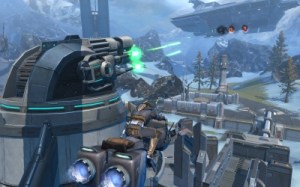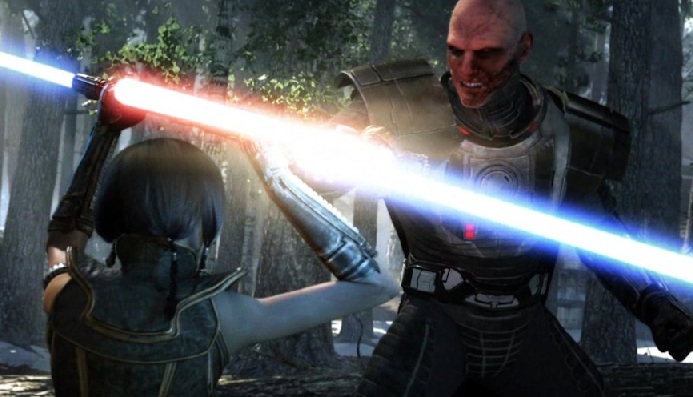 The first step in creating a massively multiplayer online (MMO) game in today’s market is to start with the world’s most popular intellectual property: Star Wars.
The first step in creating a massively multiplayer online (MMO) game in today’s market is to start with the world’s most popular intellectual property: Star Wars.
So says Dallas Dickinson, director of production for Electronic Arts’ BioWare division. In fact, the public relations folks promoting the company’s Star Wars: The Old Republic game were told — only half jokingly — to announce the game onstage as, “Star Wars, MMO (massively multiplayer online), BioWare,” and then walk off, says Richard Vogel, the company’s executive producer.
The game plan, when BioWare began developing Star Wars: The Old Republic more than six years ago, was to become a genre leader in the MMO space. The trick, said Dickinson, is to broaden the market, differentiate your game from current market leaders, build enough content to keep players invested, and update constantly. Their goal, for now, is to gain over one million subscribers in the long-term, one they’re apparently well on their way to meeting.
Vogel said that, in addition to competing with a game like Blizzard Entertainment’s World of Warcraft, Star Wars: The Old Republic is competing with many free-to-play (F2P) MMO options, like DC Universe or Star Trek Online, both with solid intellectual properties themselves.
In order to create a game worth playing, he said, BioWare had to build something that gave players real value for their subscription dollars. That meant careful innovation, building the game on a large scale, and merciless editing in the development cycle.
Innovating
 Dickinson and Vogel said that BioWare couldn’t recreate the genre just to say they had innovated. Instead, they decided to aim for the core audience of the MMO genre first, then build on that by acquiring new players. Keeping people playing an MMO game is less expensive than acquiring new players, they said.
Dickinson and Vogel said that BioWare couldn’t recreate the genre just to say they had innovated. Instead, they decided to aim for the core audience of the MMO genre first, then build on that by acquiring new players. Keeping people playing an MMO game is less expensive than acquiring new players, they said.
To focus on what core MMO players want, the production team used concepts from the Bartle Test, which proposes that there are four kinds of players of multiplayer online games: the socializer, the killer, the explorer, and the achiever.
BioWare innovated by meeting the needs of these diverse types of MMO fans. They included individual stories for each class, with family legacies that build over multiple generations, interactive cinematic dialogue with branching storylines, and multiplayer dialogue systems — all innovations in the storytelling realm. The addition of sidekicks brought a new way to add social elements to a genre that only relied on other real-time players in the past. Combat was made to look and feel like the movies, with dodging, connecting lightsabers, and true ranged combat, which Vogel bragged about being a 70+ meters system plus true cover, a genre first.
Scale
 Star Wars: The Old Republic has over 240,000 lines of fully voice acted dialogue, over 4,094 characters, and more than 321 actors. This is, the producers say, six times the amount in Dragon Age, nine times the scale of Mass Effect, and more voice over than all the previous BioWare games combined. Whew! Add in 20 full planets with over 90 unique areas to explore and around 200 hours of gameplay for each of the eight classes, and BioWare had its hands full with scale.
Star Wars: The Old Republic has over 240,000 lines of fully voice acted dialogue, over 4,094 characters, and more than 321 actors. This is, the producers say, six times the amount in Dragon Age, nine times the scale of Mass Effect, and more voice over than all the previous BioWare games combined. Whew! Add in 20 full planets with over 90 unique areas to explore and around 200 hours of gameplay for each of the eight classes, and BioWare had its hands full with scale.
Dickinson said that they won some and lost some in trying to scale up to full production with this kind of scope. He believes they did well in the voice over and writing development cycle, as well as outsourcing of art for both character and environment. Where they didn’t do so well, he said, was in the build pipeline (what gets done and by whom), data tables (tracking), and software scripting.
Both producers talked about needing to be flexible during the process of creating such a large game, though they also said they would be taking these lessons learned to future projects of any size. BioWare began this project using specific management and software strategies, had to change course over the project timeline, and at times had to go back to the original way of doing things. Without that flexibility, they say, the game would not have been as good or as on time.
Triage
 Finally, the BioWare production team needed to make sure that it stayed on task, focusing only on the things that would make a great game. One thing that any team of game developers creates, they said, was a “wouldn’t it be cool to have” list. The first thing the team did at every point was to cut these “nice to have” items, which makes the game better, but makes the team sad. Sometimes, a sad team is the price of a better game, said Vogel.
Finally, the BioWare production team needed to make sure that it stayed on task, focusing only on the things that would make a great game. One thing that any team of game developers creates, they said, was a “wouldn’t it be cool to have” list. The first thing the team did at every point was to cut these “nice to have” items, which makes the game better, but makes the team sad. Sometimes, a sad team is the price of a better game, said Vogel.
BioWare used the Colonel John Boyd fighter pilot model of decision making, which says that the winner of a dogfight is the one who makes the most decisions the fastest. A development team is like a fighter pilot, said Dickinson, in that good decisions made slowly can impact a project fatally. The team iterated through a method of observing, orienting, deciding, acting, and then observing again (the OODA model) to make super fast decisions, based on the combined experience of the production team. This led to faster decisions over time, and, said the producers, a better game on launch day.
VentureBeat's mission is to be a digital town square for technical decision-makers to gain knowledge about transformative enterprise technology and transact. Learn More

